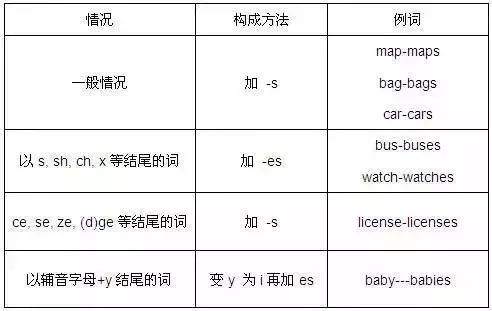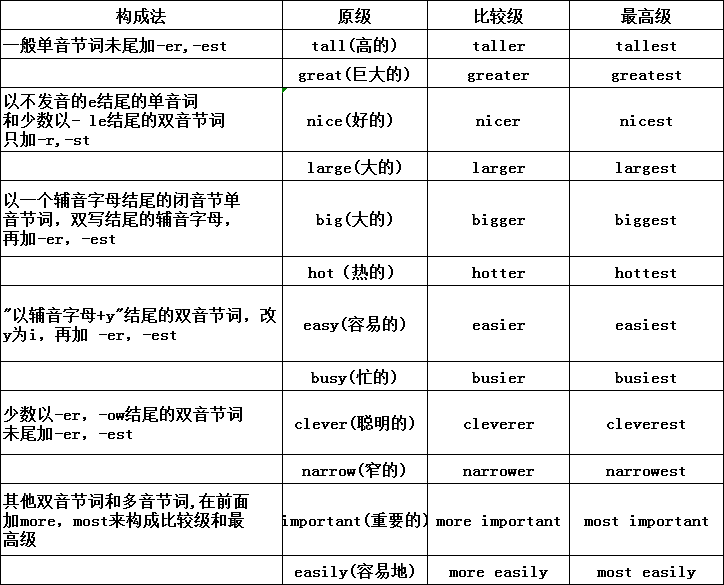词类又叫词性,英语单词根据其在句子中的功用,可以分成十个大类。
3.形容词adjective adj. happy 高兴的
4.副词 adverb adv. quickly 迅速地
8.介词preposition prep. at 在...
9.连词conjunction conj. and 和
10.感叹词interjection interj. oh 哦

在英语中有些名词可以加“‘s”来表示所有关系,带这种词尾的名词形式称为该名词的所有格,如:a teacher’s book。
1)单数名词词尾加“'s”,复数名词词尾没有s,也要加“'s”,如the boy‘s bag 男孩的书包,men’s room 男厕所。
2)若名词已有复数词尾-s ,只加“'”,如:the workers’ struggle工人的斗争。
英语中的代词,按其意义、特征及在句中的作用分为:人称代词、物主代词、指示代词、反身代词、相互代词、疑问代词、关系代词、连接代词和不定代词九种
I saw her with them, at least, I thought it was her.我看到她和他们在一起,至少我认为是她。(her做宾语,them做介词宾语,her作主补)
a. -- Who broke the vase?--谁打碎了花瓶?
如:You, he and I should return on time.

指示代词分单数(this / that)和复数(these / those)两种形式,既可作限定词又可做代词。
冠词是位于名词或名词词组之前或之后,在句子里主要是对名词起限定作用的词。冠词是一种虚词。
不定冠词a (an)与数词one 同源,是“一个”的意思。
定冠词the与指示代词this,that同源,有“那(这)个”的意思。
1)特指双方都明白的人或物:Take the medicine.把药吃了。
2)上文提到过的人或事:He bought a house. I’ve been to the house.
3)指世上独一物二的事物:the sun, the sky, the moon, the earth(敲黑板,这个是经常会在选择题中考到的知识点)
4)单数名词连用表示一类事物,如:the dollar 美元;the fox 狐狸;
5)用在序数词和形容词最高级,及形容词only, very, same等前面:
Where do you live?I live on the second floor.你住在哪?我住在二层。
They are the teachers of this school.指全体教师)
They are teachers of this school.(指部分教师)
the People‘s Republic of China中华人民共和国
8) 用在姓氏的复数名词之前,表示一家人:the Greens格林一家人 (或格林夫妇)
表示数目多少的数词叫基数词;表示顺序的数词叫序数词。
序数词的缩写形式为阿拉伯数字加序数词的最后两个字母.如:first---1st;second---2nd; third-3rd;thirty-first---31st
一,二,三要全变;(one-first; two-second;three- third)
th里有例外,8去t,(eight-eighth) 9去e(nine-ninth)
字母f代ve(five-fifth; twelve-twelfth);ty变成tie(twenty-twentieth)
若要变化几十几,只变个位就可以(twenty-one-twenty-first)
a. 主语+谓语+倍数(或分数)+ as + adj. + as
I have three times as many as you.我有你三倍那么多。
b. 主语+谓语+倍数(分数)+ the size (amount,length…) of…
The earth is 49 times the size of the moon.地球是月球的49倍。
c. 主语+谓语+倍数(分数)+ 形容词(副词)比较级+ than…
The grain output is 8 percent higher this year than that of last year.
The production of grain has been increased by four times this year.
构成:基数词代表分子,序数词代表分母。分子大于1时,分子的序数词用单数,分母序数词用复数:1/3 one-third ;3/37 three and three-sevenths
形容词用来修饰名词或代词,表示人或事物的性质、状态,和特征的程度好坏,与否。
形容词作定语修饰名词时,要放在名词的前边。但是如果形容词修饰以-thing为字尾的词语时,要放在这些词之后,例如:something nice
1)friendly,deadly,lovely,lonely,likely,lively,ugly,brotherly,仍为形容词。
daily,weekly,monthly,yearly,early
The Times is a daily paper. The Times is published daily.
某些形容词加上定冠词可以泛指一类人,与谓语动词的复数连接。
如:the dead,the living,the rich,the poor,the blind,the hungry
副词(adverb,简写为adv)是一种用来修饰动词、形容词、全句的词,说明时间、地点、程度、方式等概念的词。副词是一种半虚半实的词。
副词可分为:地点副词、方式副词、程度副词、疑问副词和连接副词。
close意思是“近”;closely 意思是“仔细地”
He is sitting close to me. Watch him closely.
late意思是“晚”;lately 意思是“最近”
You have come too late. What have you been doing lately?
大多数形容词(性质形容词)和副词有比较级和最高级的变化,即原级、比较级和最高级,用来表示事物的等级差别。原级即形容词的原形,比较级和最高级有规则变化和不规则变化两种。
有少数形容词、副词的比较级和最高级是不规则的,必须熟记。如:
old→ older/elder→ oldest/eldest
far→ further/farther→ furthest/farthest
动词根据其后是否可直接跟宾语,可分为两类,分别是:及物动词(可直接跟宾语)、不及物动词(不能直接跟宾语,若要跟宾语,必须加上某个介词)。
1)状态系动词:用来表示主语状态,只有be一词,例如:He is a teacher.
2)持续系动词:用来表示主语继续或保持一种状况或态度,主要有keep, rest, remain, stay, lie, stand,
例如:He always kept silent at meeting.
3)表像系动词:用来表示“看起来像”这一概念,主要有seem, appear, look,
例如:He looks tired.他看起来很累。
4)感官系动词:感官系动词主要有feel, smell, sound, taste,
例如:This kind of cloth feels very soft.
This flower smells very sweet.
5)变化系动词:这些系动词表示主语变成什么样,变化系动词有become, grow, turn, fall, get, go, come, run.
例如:He became mad after that.自那之后,他疯了。
6)终止系动词:表示主语已终止动作,主要有prove, turn out, 表达“证实”,“变成”之意,
例如:The search proved difficult.搜查证实很难。
连词是一种虚词, 它不能独立担任句子成分而只起连接词与词,短语与短语以及句与句的作用。
如:and, but, or, nor, so, therefore, yet, however, for, hence, as well as, both…and, not only…but also, either…or, neither…nor, (and)then等等。
so是副词,只能修饰形容词或副词。so 还可与表示数量的形容词many,few,much, little连用,形成固定搭配。
so + adj. such + a(n) + n.
so + adj. + a(n) + n. such + n. (pl.)
so + adj. + n. (pl.) such +n. (pl.)
so + adj. + n. [不可数] such +n. [不可数]
so nice a flower;such a nice flower
so many/ few flowers;such nice flowers
so much/little money;such rapid progress
so many people ;such a lot of people
介词是一种用来表示词与词、词与句之间的关系的虚词,在句中不能单独作句子成分。
介词后面一般有名词代词或相当于名词的其他词类,短语或从句作它的宾语。
介词和它的宾语构成介词词组,在句中作状语,表语,补语或介词宾语。
above在…前, about在…附近, across在…对面, after在…后面, against倚着..., along在…近旁, among在…中间, around在…周围, round在….周围, at在…处, before在...前, behind在...后, below低于..., beside在...旁边, between在...之间, by在...旁, down在...下面, from来自..., in在...里面, inside在...里面,等等。
across横越..., against对抗..., along沿着..., around绕着..., round环绕..., at朝着..., behind向…后面, etween…and…从…到...,by路过/通过..., down向…下, for向..., from从/离..., in进入..., into进入..., inside到...里面, near接近..., off脱离/除..., on向...上, out of向...外, outside向....外, over跨过..., past经过/超过..., through穿过..., to向/朝..., towards朝着..., on to到...上面, onto到...上面, up向...上, away from远离...
about大约..., after在…以后, at在… (时刻), before在…以前, by到…为止, during在…期间, for有…(之久), from从…(时)起, in在(上/下午);在(多久)以后, on在(某日), past过了…(时), since自从…(至今), through 贯穿…(期间), till直到…时, until直到…时, to到(下一时刻), ever since从那时起至今,at the beginning of在...开始时 ,at the end of在...末 , in the middle of在...当中 ,at the time of在...时
as作为/当作..., by用/由/乘坐/被..., in用…(语言), like与…一样, on骑(车)/徒(步),通过(收音机/电视机), over通过(收音机), through通过..., with用(材料),用(手/脚/耳/眼), without没有…

about关于..., except除了…, besides除了…还... for对于/就…而言, in在…(方面), of…的,有关..., on关于/有关..., to对…而言, towards针对..., with就…而言
【目的介词】 for为了..., from防止…, to为了…
【原因介词】 for因为..., with由于…, because of因为...
【比较介词】 as与…一样,like象…一样,than比...,to与…相比, unlike与…不同
































